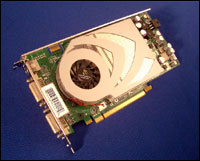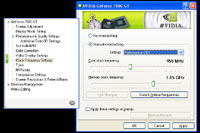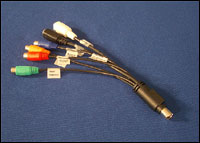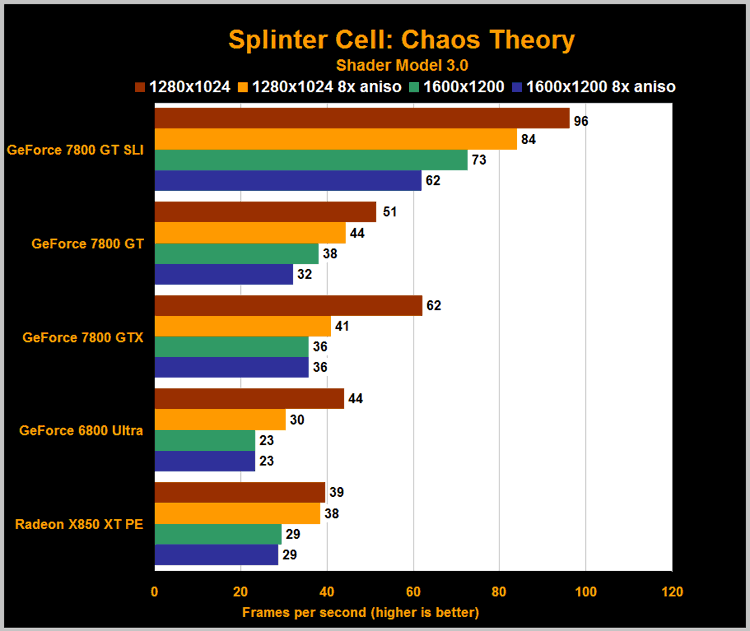7800 GT REVIEW - 7800 GT BENCHMARK -7800GT REVIEW -7800GTX BENCHMARK
![]()
|
|
 |
|||||||||||||||||||||||||||||||||||||||||||||||||||||||||||||||||||||||||||||||||||||||||||||||||||||||||||||||||||||||||||||||||||||||||||||||||||||||||||||
| Posted:2006-04-10 By hardware review Number of View:22920 |
||||||||||||||||||||||||||||||||||||||||||||||||||||||||||||||||||||||||||||||||||||||||||||||||||||||||||||||||||||||||||||||||||||||||||||||||||||||||||||||
By :hardware review Posted:2006-04-10
7800 gt review - 7800 gt benchmark -7800gt review -7800gtx benchmarkSix weeks ago Nvidia's latest and greatest graphics architecture debuted and was christened the GeForce 7800 GTX. Now, before ATI can counter-punch with its own new product (code-named R520), Nvidia has managed to push out an additional SKU, making the GeForce 7 series technology just a little bit more affordable. The GeForce 7800 GT is essentially a slightly trimmed-down version of the GTX, with a trimmed-down price to match. It launched last week at QuakeCon, and cards are already available from online merchants. Today we bring you a review of XFX's entry in this competitive market. There's a lot to like in Nvidia's new GPU.
Inside the 7800 GTThe 7800 GT's architecture bears more than a passing resemblance to the 7800 GTX. In fact, the cards are more than just related—they're in many ways identical. Take a look at the following specs:
For more on the architectural changes in the GeForce 7800 GTX, check out our original review. You may also wish to take a peek at our examination of the new Transparency Adaptive AAfeature. Everything in those articles applies to the new GT model, but you should note that a new driver has fixed the visual glitches we experienced with Transparency Adaptive AA. You'll notice that the 7800 GT has four fewer pixel shader pipelines than the GTX, and one fewer vertex shader, and it runs at a lower clock speed. On the other hand, it has the same transistor count. How is that possible? Simple…the 7800 GT is a "binned" part. What does that mean? What should Nvidia do when a 7800 GTX chip fails to run at the promised clock speed reliably, or when a pixel shader or vertex shader unit fails? It makes no sense to throw away a perfectly usable, yet lower-performance chip. The 7800 GT chip is simply a 7800 GTX that has had one vertex shader unit and one "quad" of pixel shader units disabled. The chip is then downclocked to 400MHz, paired with slower 500MHz (1.0GHz effective) memory, and sold at a reduced price. The resulting card is still wicked fast, as you'll see in our benchmarks, but it won't set you back quite as much as the GTX model. The XFX differenceXFX's cards based on the 7800 GT are very similar to Nvidia reference designs, but with one major difference: They come overclocked. The clock speeds for the GeForce 7800 GT are 400MHz for the core GPU and 500MHz (1.0GHz effective) for the memory. XFX sells its 7800 GT cards clocked up to 450MHz, a significant 12.5% boost. The memory is kicked up a very small amount, too. At 525MHz (1.05GHz effective), it is only 5% faster than the reference memory speed. It's worth noting that the reference 7800 GT operates cooler than the GTX, with a power consumption of about 85W instead of 100W+. The XFX overclocked will almost surely result in an increase in power consumption, though probably not quite as much as the GTX.
---Of course, overclocking the card isn't the only thing the XFX has done. Like some other graphics cards, the XFX comes bundled with games. In the box, we found full versions of MotoGP 2, X2: The Threat, and Far Cry. It also comes with an S-video cable, a pair of DVI-to-VGA dongles, and a video output dongle with connectors for S-video output and input, component output, and composite output and input. That's noteworthy—many video cards have those output options, but the S-video and composite input are rare.
One final note about price: Originally, the GeForce 7800 GT's "suggested retail price" was going to be $449, and for some cards it may still be. XFX has noticed that price competition for the GTX model has driven prices down from $599 to about $499, and no longer feels that a $449 price is the right target. They will be selling these 7800 GT cards starting at $399. --- 7800gt Benchmark and Testbed SetupWe ran our benchmarks on a high-end gaming PC with the following configuration:
3D performance is measured with a variety of applications: 3DMark05: Futuremark's latest synthetic graphics benchmark, 3DMark05, is a very forward-looking test. It's heavy on DX9 shaders, and runs optimized code for either Shader Model 2.0 or 3.0, depending on your card's capabilities. Far Cry: Crytek's shooter Far Cry is one of the most graphically demanding games on the market. It will run optimized code paths for shader model 3.0 or 2.0b if your card supports it. Our test runs the four demos included in the 1.3 patch, and takes their geometric mean to produce a final score. Doom 3: How can you review a graphics card without testing the latest id Software game? Nvidia almost always scores better on Doom 3, whether it's because the developers optimized more for Nvidia's architecture, or Nvidia designed with id's engine in mind. Half-Life 2: We run a couple of custom-recorded demos of single player play in Half-Life 2, then take their geometric mean to produce an overall score. It's a great example of a high-end, very efficient and optimized game engine. Painkiller: With the 1.61 patch, many of the little discrepancies with using Painkiller as a benchmark have been ironed out. It's not especially heavy on shaders and the like, but the long view distances and gobs of enemies and explosions make this a good test. Splinter Cell: Chaos Theory: UbiSoft's latest Sam Fischer adventure uses an all-new engine, rich with detail and heavy on shaders. Splinter Cell: Chaos Theorycan operate in a Shader Model 1.1 mode, applicable to all cards, or a Shader Model 3.0 mode for Nvidia cards. We run both, and enable the optional high dynamic range rendering mode with SM 3.0. Note that anti-aliasing doesn't work with HDR rendering (in this or any other game). As good as these games for testing graphics performance, some of them really don't push the latest high-end graphics cards hard enough. In particular, Painkiller is starting to show its age and is rapidly becoming CPU-limited on high-end cards. We have dropped UT 2004 from our testing because it is almost always CPU limited, even on more modest-priced hardware. We put the GeForce 7800 GT up against two of Nvidia's other high-end cards: the GeForce 7800 GTX and GeForce 6800 Ultra. Also included is ATI's fastest and most expensive card, the Radeon X850 XT PE. Naturally, with Nvidia's push to greater graphics performance with SLI, and considering this is our first review of the new GT architecture, we tested the XFX cards in SLI configuration as well. We used driver revision 77.73 for the Nvidia-based cards, and Catalyst 5.6 for the ATI card. benchmark 7800gt 3DMark05 results( 7800 gt review )Futuremark's latest 3D benchmark is the only synthetic test we use to judge video card performance. That is, it's the only test that isn't an actual game. Why? Simply put, we believe that it's a pretty good look at future game graphics. The tests are well designed to mimic the type of code and content we'll see in games coming over the next year or so—those that utilize DirectX 9 shaders heavily. The overclocked nature of the XFX brand 7800 GT cards helps it keep pace with the more expensive GTX (at stock speeds). It's less than 7% slower, which isn't bad for a $100 price difference. Two cards in SLI deliver just amazing performance, speeding things up between 50% and 80% over a single card. ------ 7800gt benchmark Painkiller( 7800 gt review )Painkiller exhibited some odd irregularities with its first attempt at a benchmark mode, but the 1.61 patch has addressed those. It is a reasonably impressive game with a good benchmark mode, but it simply doesn't tax graphics cards like it did when it was released. The results here are a little odd. The 7800 GT actually runs Painkiller more slowly than the 6800 Ultra. What's more, SLI mode isn't really any faster than a single card. We double-checked all our settings and the configuration of the test machine, and everything was in order. This is just an odd aberration—a repeatable result that isn't at all what we expected. ---- 7800gt benchmark Half-Life 2 and Doom3( 7800 gt review )Valve's Half-Life 2 is one of the more graphically advanced games available today, making fairly heavy use of shaders in some areas. It is well engineered and optimized to make the most out of almost any graphics card. e 7800 GT delivers much better Half-Life 2 performance than the 6800 Ultra when you crank up the resolution and add AA and AF (anisotropic filtering). It's a little disheartening to see that this 20-pipeline "next generation" card from Nvidia really only runs the game a few frames per second faster than ATI's 16-pipeline "old technology" card. But then, ATI has always done very well in this benchmark. If Half-Life 2 is said to be ATI's best game, then Doom 3 is Nvidia's. Again, the new $400 card pushes well past the old one, when you run the game at very high resolution with AA and AF. During normal gameplay, Doom 3 is limited to 60fps, and a single GeForce 7800 GT achieves that and more at all but the highest test settings. Even then, 50fps is no slouch. Of course, with two cards in SLI mode, you can average well over 60fps all the time. --- 7800gt benchmakr Far Cry andSplinter Cell: Chaos Theory ( 7800 gt review )With vast outdoor scenes flush with vegetation, complex water, and a fair amount of normal mapping, Far Cry pushes most graphics cards to the limit. The 1.3 patch ships with four built-in demos. We ran all four and take their geometric mean to produce a final score. Far Cry continues to impress us with its ability to push graphics hardware to the limit. The real benefit of XFX's overclocked 7800 GT again becomes apparent at the highest resolutions and with AA and AF enabled, but it can't match the 7800 GTX. SLI offers huge improvements here. A new patch to Splinter Cell: Chaos Theory enables Shader Model 2.0 support, letting ATI cards perform HDR rendering, parallax mapping, and all the other effects that used to be reserved for the Shader Model 3.0 path. We run the benchmark in both SM 1.1 mode and SM 3.0 with HDR. Anti-aliasing is incompatible with HDR rendering, so we run our two test resolutions with and without AF instead
Now that a new patch enables us to get an apples-to-apples view of performance, we uncover some interesting things. With HDR lighting, parallax mapping, and the other Shader Model 2.0/3.0 features, the ATI card drastically outpaces the GeForce 6800 Ultra it originally competed with. Nvidia's ability to deliver its new architecture first has given it a big performance advantage in the 7 series cards. There are a couple of render states where XFX's 7800 GT card actually outpaces the 7800 GTX—chalk that up to its overclocked nature. Final Thoughts/Should You Buy One?The GeForce 7800 GT is a good product, overall. Though the price is more affordable, it's still definitely a high-end card. The group of gamers willing to spend $400 on a video card is still rather small (let alone those who will spend twice that to run in SLI mode). Having said that, the price/performance ratio of the GT model seems a bit easier to swallow than the GTX, especially when compared with its original $600 price. By disabling a single vertex pipeline and four pixel pipelines, Nvidia is able to offer a chip that still has fantastic capabilities and speed at a reduced price, while making better use of some of the chips that, when they came off the line, didn't quite pass the test to go on 7800 GTX cards. It's a better deal for everyone. It also gives them a bigger leg-up on ATI, which has not announced or previewed, let alone shipped, the first card in its next-generation R5xx family. Check out other coverage of 3D graphics here. The fact is, 7800 GTX cards have dropped to about $500 now, and several vendors are offering overclocked models for a bit more. For the GT model, XFX is offering great value by coming in at $400 with an overclocked card that does video in/video out, and comes with a decent game bundle. If you're in the market for a $400 video card, it's going to be hard to find a better performer than this one or a card with more complete features and software
we would be happy to answer for your question . if you have suggestion or comment
regarding this review our support would be glad to help just join our forum and ask u will get the best answer
to discuss check our forum section :-) RATE THIS REVIEW | ||||||||||||||||||||||||||||||||||||||||||||||||||||||||||||||||||||||||||||||||||||||||||||||||||||||||||||||||||||||||||||||||||||||||||||||||||||||||||||||
![]()

7800 gt review - 7800 gt benchmark -7800gt review -7800gtx benchmark
7800 gt review - 7800 gt benchmark -7800gt review -7800gtx benchmark


7600gt review
7600gt is the middle card range.
We already benchmarked this video card and found that ...

 geforce 8800gtx and 8800gts
geforce 8800gtx and 8800gts  Xtreview software download Section
Xtreview software download Section  AMD TURION 64 X2 REVIEW
AMD TURION 64 X2 REVIEW  INTEL PENTIUM D 920 , INTEL PENTIUM D 930
INTEL PENTIUM D 920 , INTEL PENTIUM D 930  6800XT REVIEW
6800XT REVIEW  computer hardware REVIEW
computer hardware REVIEW  INTEL CONROE CORE DUO 2 REVIEW VS AMD AM2
INTEL CONROE CORE DUO 2 REVIEW VS AMD AM2  INTEL PENTIUM D 805 INTEL D805
INTEL PENTIUM D 805 INTEL D805  Free desktop wallpaper
Free desktop wallpaper  online fighting game
online fighting game  Xtreview price comparison center
Xtreview price comparison center 

- The new version of GPU-Z finally kills the belief in the miracle of Vega transformation
- The motherboard manufacturer confirms the characteristics of the processors Coffee Lake
- We are looking for copper coolers on NVIDIA Volta computing accelerators
- Unofficially about Intels plans to release 300-series chipset
- The Japanese representation of AMD offered monetary compensation to the first buyers of Ryzen Threadripper
- This year will not be released more than 45 million motherboards
- TSMC denies the presentation of charges from the antimonopoly authorities
- Radeon RX Vega 64 at frequencies 1802-1000 MHz updated the record GPUPI 1B
- AMD itself would like to believe that mobile processors Ryzen have already been released
- AMD Vega 20 will find application in accelerating computations
- Pre-orders for new iPhone start next week
- Radeon RX Vega 57, 58 and 59: the wonders of transformation
- ASML starts commercial delivery of EUV-scanners
- The older Skylake processors with a free multiplier are removed from production
- Meizu will release Android-smartphone based on Helio P40
- AMD Bristol Ridge processors are also available in American retail
- The fate of Toshiba Memory can be solved to the next environment
- duo GeForce GTX 1080 Ti in GPUPI 1B at frequencies of 2480-10320 MHz
- New Kentsfield overclocking record up to 5204 MHz
- Lenovo released Android-smartphone K8



computer news computer parts review Old Forum Downloads New Forum Login Join Articles terms Hardware blog Sitemap Get Freebies











